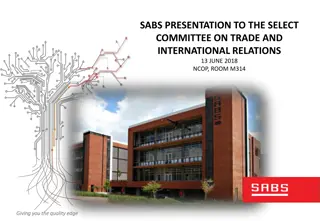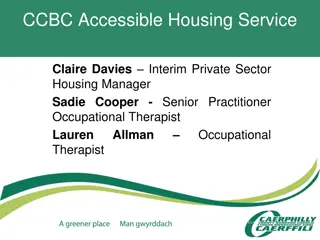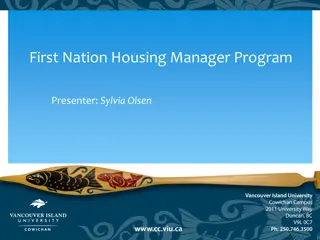Leveraging Local Production for South African Public Housing Program
This study explores opportunities for local production of construction materials using the South African Public Housing Programme as a procurement lever. It aims to align public procurement with industrial policy imperatives to support local manufacturing, job creation, and infrastructure development. The study methodology involves analyzing literature, economic data, and stakeholder perspectives to formulate recommendations for enhancing local production in the public housing sector.
Download Presentation

Please find below an Image/Link to download the presentation.
The content on the website is provided AS IS for your information and personal use only. It may not be sold, licensed, or shared on other websites without obtaining consent from the author.If you encounter any issues during the download, it is possible that the publisher has removed the file from their server.
You are allowed to download the files provided on this website for personal or commercial use, subject to the condition that they are used lawfully. All files are the property of their respective owners.
The content on the website is provided AS IS for your information and personal use only. It may not be sold, licensed, or shared on other websites without obtaining consent from the author.
E N D
Presentation Transcript
An Assessment of Opportunities for Local Production of An Assessment of Opportunities for Local Production of Construction and Building Materials using the South Construction and Building Materials using the South African Public Housing Programme as a Procurement African Public Housing Programme as a Procurement Lever Lever TIPS: International Conference on Manufacturing Led Growth for Employment and Equality 21 May 2014 Tebogo Makube (Ph.D) Disclaimer: views presented here are the author s sole responsibility and not those of his employer.
Outline of the Presentation Aims and objectives of the study Methodology used in the study Background on the governance and institutional framework for housing delivery Analysis and findings of the study Recommendations 2
Aims and objectives of the study Both the New Growth Path (NGP) and the Industrial Policy Action Plan (IPAP) identify the need to leverage public procurement to support local manufacturing, especially in value added, tradable and labour intensive industries Public expenditure and procurement are considered strategic levers for industrial development The study assesses opportunities for local production and manufacturing of construction materials using the South African public programme as a procurement lever Currently the procurement of the public housing programme is not strategic and also not directly linked to industrial policy imperatives Public housing programme must be linked to industrial policy objectives and that the government should prioritise the designation of construction materials and products for local production Local production is important in the delivery of infrastructure, access to housing, job creation and diversification of enterprise and supplier development in the sector 3
Methodology used in the study This study reviewed literature and official government policies on the delivery of public housing programmes in South Africa It analysed financial and economic data to explore trends in the public housing delivery programme. Data on the import and export trends in the construction materials sector was also reviewed. Stakeholder views mostly by government departments were helpful in making an informed view of the challenges and opportunities facing the public housing sector. The analysis was used to formulate recommendations for the designation and localisation of construction materials for public housing delivery in SA 4
Governance and institutional framework for housing delivery In South Africa, the right to housing is enshrined in Section 26 of the Bill of Rights .the state must take reasonable legislative and other measures, within its available resources to achieve the progressive realisation of this right . The Constitution requires the government to set aside resources towards the progressive realisation and other socio-economic rights listed in the Bill of Rights Social and economic rights such as rights to access to housing have significant policy and fiscal implications In terms of schedules 4A and 5A of the South Africa Constitution, housing delivery is a concurrent function of both national and provincial governments Legislation provides that where the housing function can best be administered locally, it can by agreement, be assigned or delegated to a municipality provided that the municipality has the capacity and resources to perform the function 5
Supply and demand side issues affecting public housing delivery Changing housing policies Reconstruction and Development Programme (RDP) housing, Breaking New Ground (BNG): the development of sustainable human settlements, upgrading informal settlements and the Finance-Linked Individual Subsidy Programme (FLISP) The National Norms and Standards for the Construction of Stand Alone Residential Dwellings (2007) All standalone houses constructed through application of the National Housing Programmes must comply with the norms and standards with regards to technical specifications, including environmentally efficient design proposals Public procurement policy framework and legislation in South Africa Magoro & Brynard (2010) contend that housing departments are largely incompetent when it comes to implementing the preferential procurement policy 6
Housing delivery statistics 2.6 million RDP houses have been built, however, the housing backlog remains on the increase Housing Backlog: 1996-2011 25.0 Informal dwellings per province 2002 2005 2008 2010 Year 1996 1.5 million houses 2001 1.8 million houses 2011 2.1 million houses Backlog 20.0 Informal dwellings (%) 15.0 10.0 5.0 0.0 Source: Dept of Human Settlements, 2011. Source: Stats SA, 2010 General Household Survey 7
Provincial governments expenditure on the public housing programme Integrated human settlements development grant expenditure, (2005/06-2011/12) 2005/06 2006/07 2007/08 2008/09 Pre-audited outcome 10,344 2009/10 2010/11 2011/12 Outcome Medium-term estimates R'million Eastern Cape Free State Gauteng KwaZulu Natal Limpopo Mpumalanga Northen Cape North West Western Total (%) growth (average annual) Eastern Cape Free State Gauteng KwaZulu Natal Limpopo Mpumalanga Northen Cape North West Western Total Source: National Treasury, 2010 607 370 2005/06- 2008/09 17.4% 32.4% 27.0% 25.9% 29.1% 43.6% 28.6% 15.7% 33.3% 26.8% 637 528 337 467 981 859 1,313 963 3,187 2,180 997 795 325 1,100 1,581 12,441 2008/09- 2011/12 22.5% 17.1% 15.9% 24.6% 19.7% 11.9% 12.6% 18.3% 17.9% 18.5% 1,599 1,301 3,772 2,714 1,235 976 273 1,289 1,869 15,028 1,803 1,380 4,323 3,150 1,415 1,118 313 1,578 2,142 17,222 1,357 816 383 269 103 615 552 5,072 1,760 1,075 605 330 105 697 769 6,506 2,614 1,311 633 652 231 786 1,122 8,153 2,778 1,627 825 797 219 952 1,306 8
Housing delivery statistics A percentage of households with fully owned properties increased from 53.1% in 2002 to 58.1% in 2010. However, there is also a challenge in the gap market which is pushing demand for rental houses 70.0 Fully Owned Partially Owned Renting Other 60.0 50.0 Household dwellings (%) 40.0 30.0 20.0 10.0 0.0 2002 2003 2004 2005 2006 Year 2007 2008 2009 2010 9
Housing delivery statistics Beneficiaries of RDPHouses per gender Quality issues 14.0 35.0 Male Female Households Weak Walls Weak Roof 30.0 12.0 Percentage (%) 25.0 10.0 Govt. Housing Subsidy (%) 20.0 8.0 15.0 6.0 10.0 4.0 5.0 0.0 2.0 0.0 2002 2003 2004 2005 2006 Year 2007 2008 2009 2010 10 Source: Stats SA, 2010 General Household Survey
Building and construction cost indicators Building and construction investment cost indicators Public housing programme cost indicators Financing costs 4% Building & Construction R158.6b Marketing 5% Profit 20% Building R102.6b Construction R56b Internal finishes 16% Cost structure Structural frame 16% Materials R95.1b Labour R63.4b Sub-structure 6% Internal services 6% In 2008, new residential buildings accounted for about 25% of the total national building and construction expenditure of R158.6 billion. Bulk and link structure 23% Land 4% Materials typically account for 60% of the costs while labour accounts for the remaining 40% (Mapiravana & Ampofo-Anti, 2011). 0% 5% 10% 15% 20% 25% Costs (%) 11
An overview of leading construction materials manufactures in SA According to Statistics SA the building materials market is valued at approximately R70bn per annum Building Product Cement Reinforcing steel and sections Bricks and walling Flloring Roofing and vertical cladding Sand and aggregate Doors Frames Plumbing pipes and fittings Roof Trusses Ceilings Glass and mirrors Taps Geysers Paving Windowsills and, fasciaboards Guttering and downpipes Source: DBSA, 2011; Who Owns Whom, 2012 Leading Manaufacturers PPC Holcim Macsteel Crammic Nouwens Macsteel Lafarge Nulu Dura Petzetakis Federated Everite AFGLASS Watertech Frnake Rosema Lafarge Highveld Briko Domo Ceramic Ind Lafarge Afrimat WG Wearne Van Acht Nulu Incledon Iliad Lafarge Imports Imports NPC Cisco Rosema Mittal Corobrick Belgotex Mittal Holcim TDM Wispeco Marley Swartland Van Acht DPI Mitek BPB Gypsum PFG Glass Cobra Kwikot Corobrik Everite Hans Merensky Buildmand Briko 12 Everite Petzetakis Main Ind.
Market share of the major construction materials in SA Rand market share (%) 16.5% 11.1% 10.6% 9.3% 8.3% 6.7% 5.7% 5.2% 4.9% 4.3% 4.1% 2.7% 2.1% 1.7% 1.7% 1.2% 1.1% 0.9% 0.8% 0.7% 0.4% Material group Ranking 1 2 3 4 5 6 7 8 9 10 11 12 13 14 15 16 17 18 19 20 21 Cement and reinforced concrete Reinforcing steel and sections Walling Flooring Roofing and vertical cladding Aggregate and sand Decorative paint Doors & frames Plumbing pipes & fittings Particle board & MDF* Roof trusses Glass & mirrors Sanware Taps & fittings Ceramic wall tiles Ceilings and partitioning Geysers Insulation Paving Windowsills, fasciaboards & bargeboards Guttering & downpipes * 35% of PB & Medium Density Fibreboard(MDF) is used in the Building Industry & 65% in Furniture Source: Own calculations, compiled from Mapiravana, 2010; CIDB, 2011 13
Estimate of some construction materials imports and exports: 2008 Product/material Insulation Particle board Medium density fibreboard Glass Plastic piping Timber prefab trusses Steel prefab trusses Window frames Door frames Carpet Ceramic tiles Galvanised Iron Chromadek/Globalcoat Steel tiles Cement Range Source: DBSA, 2011 Imports (%) 20-25 5-10 90 2-38 2 10 15 2 2 5 35 19-44 15-25 1 5 5-44 Exports (%) 0-25 Minimal 0 5-15 6 10 85 5 0 10 11 25 35 20 1 0-85 14
Construction Industry Supply Chain and Barriers to Entry The industry is a high volume, low margins industry which requires enough initial capital investment to manufacture adequate stock As major retailers grew, they started importing their own products, buying directly from the manufacturers or forming buying groups to buy directly from manufacturers thus bypassing the wholesaler Some wholesalers chose to diversify and added either manufacturing or retail operations to their wholesale operation New entrants have to build relationships with suppliers and customers, competing with other players who have existing supply chain relationships and an entrenched market position 15
Construction Industry Supply Chain and Barriers to Entry The three largest building material retailers that have wholesale operations are: Massmart through Builders Warehouse and Builders Express targets lower- income home owners and small contractors in dense residential, township, rural and developing areas Build It, which provides materials to building contractors in addition to its retail operations Iliad Africa Limited which is located mostly in coastal towns focuses on sourcing, distributing, wholesaling and retailing general and specialised building materials 16
Recommendations Harmonisation of norms and standards for construction materials To date, the only compulsory standard in the construction industry is that for cement (DBSA, 2011) Harmonised standards should be established as a matter of urgency; this will assist in affording access to the construction materials manufacturing industry to diversified suppliers and to ensure the degree of market transparency The NHBRC, SABS; Agr ment South Africa must work together in harmonising norms & standards for construction materials, and in improving regulatory compliance and performance. Reform of the procurement system and support for supplier development and localisation in the construction materials manufacturing industry There is a need to rationalise and align a plethora of Sector Charters influencing B- BBEE in the sector (Construction Charter :design and construction sectors; Mining Charter : cement, aggregate and sand; Manufacturing Charter; Wholesale and Retail Charter; and Financial Charter). 17
Recommendations Government should prioritise the designation of construction materials and products for its infrastructure programme In developing localisation strategies, it is important that the Department of Trade & Industry engages strategic departments involved in the delivery and financing of housing, including the industry and financial institutions in the housing delivery value chain Transversal contracts will lead to economies of scale and savings on the fiscus Review the role of the state in housing delivery and empower beneficiaries in the construction of their houses Government is facing a mammoth task to deliver houses amid growing demand, it also carries the responsibility of providing warranties for poor workmanship There is a need to review the way low cost houses are delivered and relieve the government of risks involved in the construction of such houses A technical housing support service managed by a possibly revamped NHBRC must assist beneficiaries to build structures of their choice in compliance with approved plans as well as norms and standards The state can provide land, infrastructure and subsidies. 18
Thank You Thank You 19























